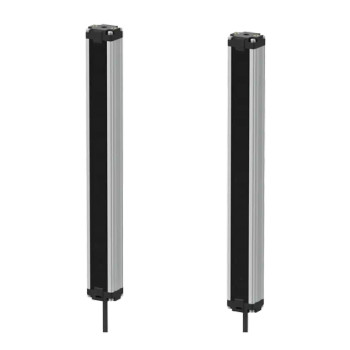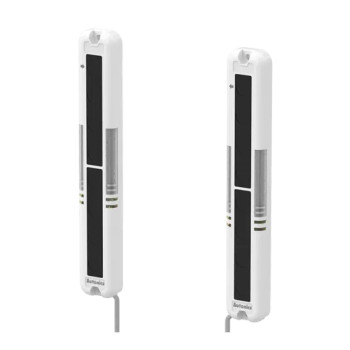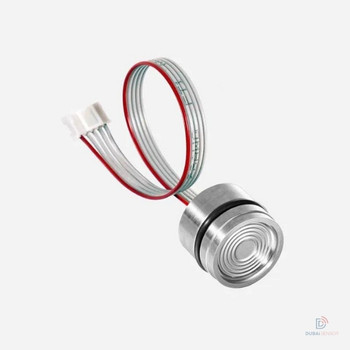Description
Product Overview
The BWC Series cross-beam area sensors employ a 3-point cross-beam detection method to significantly reduce non-detection areas, ensuring accurate and reliable detection in various environments. Available in 14 different configurations, the BWC Series offers flexibility based on the number of optical axes, optical pitch, and detection area size. These sensors are designed to perform reliably even in environments with high ambient lighting, up to 100,000 lux. The built-in self-diagnosis output function helps minimize detection errors caused by dust or debris, enhancing the overall reliability of the system. Additionally, the BWC Series comes equipped with user-friendly features such as an installation mode function, mutual interference prevention, and various self-diagnosis capabilities.
Key Features
- Minimized Non-Detection Areas: The BWC Series uses a 3-point cross-beam detection method, reducing the chances of non-detection and improving sensing accuracy.
- Long Sensing Distance: Capable of detecting objects up to 7 meters away, ensuring performance across various applications.
- Versatile Configurations: The series offers 14 configurations, with options for the number of optical axes (from 4 to 20), optical pitch (40mm or 80mm), and detection area size (ranging from 120mm to 1,040mm).
- High Ambient Light Resistance: Reliable operation in environments with ambient lighting up to 100,000 lux.
- Self-Diagnosis Output: Monitors sensing screen pollution and optical axis blockage, allowing external devices to check for errors and ensuring ongoing system reliability.
- Ease of Installation: The installation mode function simplifies setup, making it user-friendly.
- Mutual Interference Prevention: Prevents operational interference between multiple sensors installed in proximity.
- Bright LED Indicators: Easily monitor the operational status with bright LED indicators on both the emitter and receiver.
- Compliance with Standards: The BWC80-14HD model meets the Korean Railway Standards.
- Durable Construction: IP67 protection rating (IEC standard) ensures the sensor's resilience in harsh environmental conditions.
Product Components
Each BWC Series package includes:
- 1 x BWC Series Sensor
- 1 x Instruction Manual
- 4 x Bracket A
- 4 x Bracket B
- 8 x Fixing Bolts
Ordering Information
To order the BWC Series sensor, select the desired model based on the following structure:
- Optical Axis Pitch (in mm): Indicated by a number (40mm or 80mm).
- Number of Optical Axes: Choose from 4 to 20 optical axes.
- Operation Mode: Choose "H" for Light ON mode or "HD" for Dark ON mode.
Please note that not all combinations may be available.
Additional Accessories
Connection Cables:
- Emitter Cables: Available as CID4-□T models in lengths of 3, 5, 7, 10, or 15 meters (Black color).
- Receiver Cables: Available as CID4-□R models in corresponding lengths (Gray color).
These cables must be purchased separately.
Documents
Can't find the information you need? Our datasheets have all the details. Access them here:
Additional Information
Sensing Method: |
Through-beam with 3-point cross-beam netting type |
Light Source: |
Infrared LED (850 nm modulated light) |
Sensing Distance: |
1.0 to 7.0 meters |
Sensing Target: |
Opaque materials, minimum sizes of Ø 50 mm or Ø 90 mm depending on the model |
Number of Optical Axes: |
4, 10, 12, 16, 18, or 20 |
Sensing Height: |
120mm to 1,040mm |
Optical Axis Pitch: |
40mm or 80mm |
Response Time: |
50 ms or less |
Operation Modes: |
Light ON (H) or Dark ON (HD) |
Power Supply: |
12 - 24 VDC (ripple P-P ≤ 10%) |
Current Consumption: |
100 mA or less |
Control Output: |
NPN open collector output, Load Voltage: 30 VDC max, Load Current: 100 mA max (50 mA for self-diagnosis output) |
Protection Rating: |
IP67 (IEC standard) |
Environmental Resistance: |
Operating temperature: -10 to 55°C, Storage temperature: -20 to 60°C, Ambient light resistance: up to 100,000 lux |
Compliance: |
Korean Railway Standards (specific models) |
Weight: |
Approximately 1.7 kg (packaged), 2.1 kg for certain models |










